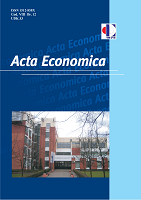УТИЦАЈ МЈЕРА ШТЕДЊЕ НА ЕКОНОМСКИ РАСТ ЗЕМАЉА ЕВРОЗОНЕ
THE IMPACT OF AUSTERITY MEASURES ON ECONOMIC GROWTH IN THE EUROZONE
Author(s): Vasilj Žarković, Milenko Krajišnik, Dragan GligoricSubject(s): Economic development, EU-Accession / EU-DEvelopment, Fiscal Politics / Budgeting
Published by: Економски факултет Универзитета у Бањој Луци
Keywords: austerity measures; economic growth; fiscal multiplier; Eurozone;
Summary/Abstract: At the time when most of the countries began to recover from economic crisis, sovereign debt crisis started in Eurozone. Eurozone members created mechanisms for assistance in order to prevent bankruptcy of heavily indebted countries and safeguard the stability of the Eurozone and the euro. Precondition for using the Eurozone mechanisms of assistance were appliance of strict austerity measures. This was followed by the Treaty on Stability, Coordination and Governance in order to have a more severe compliance of the Maastricht fiscal criteria. Requirements for implementation of austerity measures are contradictory to the Keynesian central preposition which says that the right time for austerity is the period of growth not period of crisis. This paper seeks to answer the question: Did austerity measures contributed to the decline of real GDP from 2010 to 2013? Regression analysis was conducted on a sample of 13 Eurozone countries. The results show that the growth rates of real GDP are largely caused by austerity measures. The fiscal multiplier of 1.98 indicates that the increase in savings of 1% leads to a fall of real GDP by 1.98%.
Journal: Acta Economica
- Issue Year: 12/2014
- Issue No: 21
- Page Range: 43-65
- Page Count: 23
- Language: Serbian

